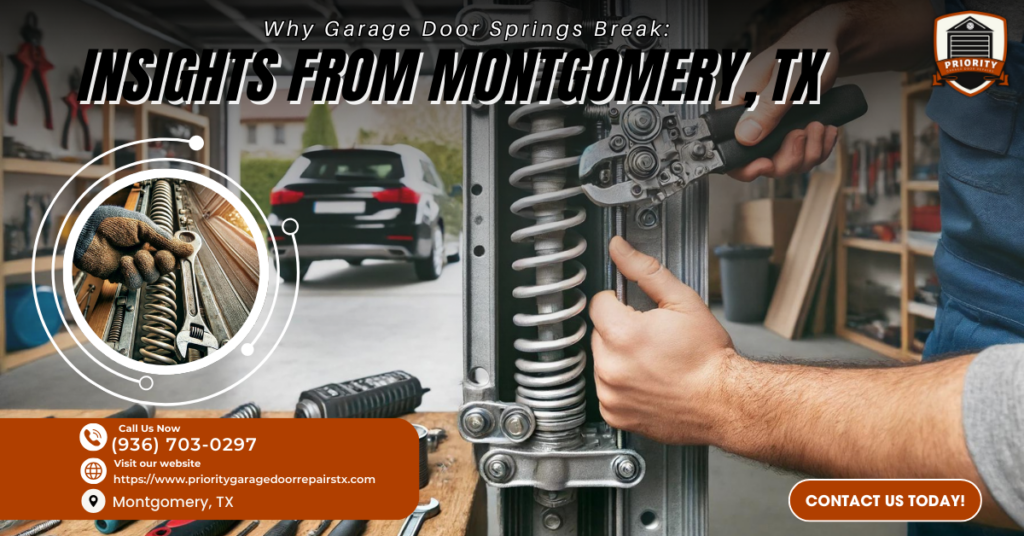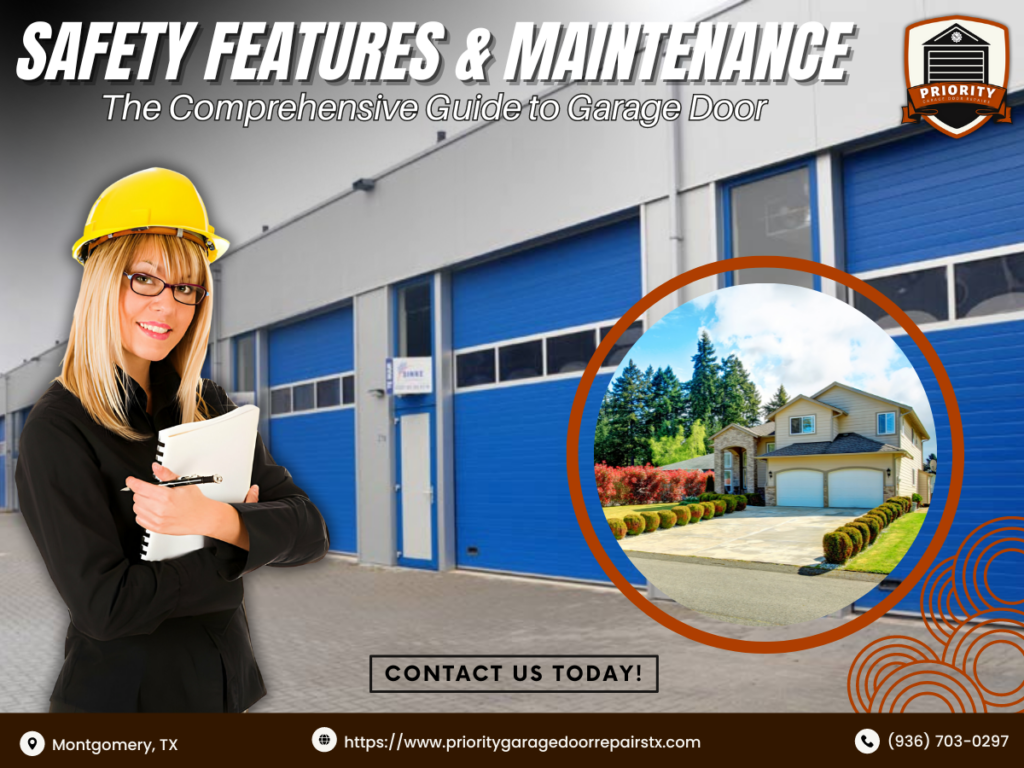
Discover why garage door springs break with insights from Montgomery, TX. Learn the causes, prevention tips, and how Priority Garage Door Repair can help you with garage door spring replacement, repair, and installation. Serving Montgomery and surrounding areas.
Hey there! Have you ever had your garage door suddenly stop working, leaving you stranded and frustrated? If so, you might have experienced a common issue—broken garage door springs. Here at Priority Garage Door Repair, we’ve seen it all. Today, let’s dive into why garage door springs break and what you can do to prevent this inconvenient problem.
Understanding Garage Door Springs
Importance of Garage Door Springs
Garage door springs play a crucial role in the smooth operation of your garage door. They bear the weight of the door, making it easy to open and close. Without them, your garage door simply wouldn’t function properly.
Common Types of Garage Door Springs
There are two main types of garage door springs: torsion springs and extension springs. Torsion springs are mounted above the door and use torque to lift it, while extension springs are found on either side of the door and extend to provide the lifting force. Both types are essential, but they also have their unique challenges and lifespans.
How Garage Door Springs Work
The Physics Behind the Operation
Garage door springs operate on the principles of tension and balance. When the door is closed, the springs are under maximum tension. When you open the door, the tension releases, making it easier to lift.
Role in Balancing the Door
The springs ensure that the door is balanced, which prevents it from falling abruptly. Properly functioning springs make lifting the door almost effortless, whether manually or with an automatic opener.
Common Causes of Garage Door Spring Failure
Normal Wear and Tear
Like any mechanical component, garage door springs undergo wear and tear over time. The average lifespan of torsion springs is about 10,000 cycles (one cycle being a complete opening and closing of the door), while extension springs may last a bit longer. Signs of aging springs include noticeable gaps in the coils or rust.
Rust and Corrosion
Rust is a silent killer for garage door springs. The moisture in the air, especially in humid areas like Montgomery, TX, can cause rust to form, weakening the springs. Regular lubrication and using weather-resistant springs can help mitigate this issue.
Environmental Factors Contributing to Spring Breakage
Temperature Fluctuations
Montgomery experiences significant temperature swings, which can affect your garage door springs. Extreme cold can make the metal brittle, while extreme heat can cause it to expand and contract, leading to fatigue and breakage.
Impact of Moisture and Rain
Moisture from rain or high humidity levels can accelerate rust formation, weakening the springs over time. Applying a protective coating and regular maintenance can help protect against moisture damage.
Installation and Maintenance Errors
Improper Installation Techniques
Incorrect installation can lead to premature spring failure. This is why it’s essential to have a professional install your garage door springs to ensure they are set up correctly and safely.
Lack of Regular Maintenance
Regular maintenance, like lubricating the springs and checking for wear, can significantly extend their lifespan. While some maintenance tasks can be DIY, having a professional service your garage door annually can catch potential issues early.
Overuse and Heavy Usage
Frequency of Garage Door Use
If your garage door is used multiple times a day, the springs will wear out faster. Consider the average usage and be prepared for more frequent maintenance if your door is heavily used.
Excessive Weight on the Door
Additional loads, like adding insulation or heavy door accessories, can put extra strain on the springs. Ensure that your springs are adjusted to accommodate any additional weight to prevent premature breakage.
Manufacturing Defects and Quality Issues
Identifying Poor Quality Springs
Not all garage door springs are created equal. Cheaper, low-quality springs may not last as long as high-quality ones. Look for reliable brands and consider investing a bit more upfront for better performance.
Recognizing Early Signs of Defects
Visual and functional indicators of defective springs include uneven lifting, noisy operation, and visible wear. If you notice any of these signs, it’s time to call in a professional for an inspection.
Accidents and Physical Damage
Impact of Accidental Damage
Accidents happen, and your garage door can take a hit from a vehicle or other impacts, damaging the springs. If an accident occurs, inspect the springs immediately or call a professional.
External Physical Forces
External forces like vandalism or unintentional impacts can damage your garage door springs. Reinforcing your garage door and ensuring it’s secure can help prevent such incidents.
Case Studies: Spring Failures in Montgomery, TX
Local Climate and Its Effects
Montgomery, TX, has a unique climate that can affect garage door springs. The hot, humid summers and cooler winters can lead to faster wear and tear. Real-life examples from Montgomery residents show how local weather impacts spring longevity.
Customer Stories and Testimonials
Our customers in Montgomery have shared their experiences with garage door spring failures. These stories highlight the importance of regular maintenance and choosing high-quality springs. One resident, Sarah, mentioned how she ignored the creaky noise from her garage door until one day, it wouldn’t open at all. It turned out the spring had broken due to rust and overuse.
Prevention and Proactive Measures
Regular Inspection Schedules
Creating a maintenance calendar can help you keep track of when to inspect and service your garage door springs. Regular checks can catch potential problems before they turn into costly repairs.
Choosing the Right Springs
When it comes time for a replacement, selecting the right springs is crucial. Consider factors like weight, door type, and usage frequency. Professional advice can ensure you get the best springs for your needs.
Conclusion
In summary, understanding why garage door springs break can help you take preventive measures and avoid unexpected inconveniences. Regular maintenance, proper installation, and choosing high-quality springs are key. If you’re in Montgomery, TX, and need garage door spring replacement, repair, or installation, Priority Garage Door Repair is here to help. We serve both residential and commercial customers, offering emergency garage door repair services to ensure your door is always in top shape.
Living in Montgomery means you get to enjoy beautiful spots like Lake Conroe and the historic Fernland Historical Park, but it also means dealing with the unique climate challenges that can affect your garage door springs. Don’t let a broken spring disrupt your day. Reach out to Priority Garage Door Repair for professional, reliable service. Whether it’s routine maintenance or an emergency fix, we’ve got you covered.
FAQs
Q: How often should I replace my garage door springs? A: Garage door springs typically last about 10,000 cycles. Depending on your usage, this could be anywhere from 7 to 10 years. Regular maintenance can help extend their lifespan.
Q: Can I replace the garage door springs myself? A: While it’s possible to replace springs yourself, it’s not recommended due to the high tension they are under. It’s safer and more efficient to have a professional handle it.
Q: What are the signs that my garage door springs need replacement? A: Signs include visible wear, rust, uneven lifting, and unusual noises. If your door is difficult to open or closes too quickly, it’s time for an inspection.
Have you had any issues with your garage door springs lately? Share your experiences or ask any questions in the comments below! We’re here to help.Contact Priority Garage Door Repair today for expert garage door spring replacement and repair in Montgomery, TX!


